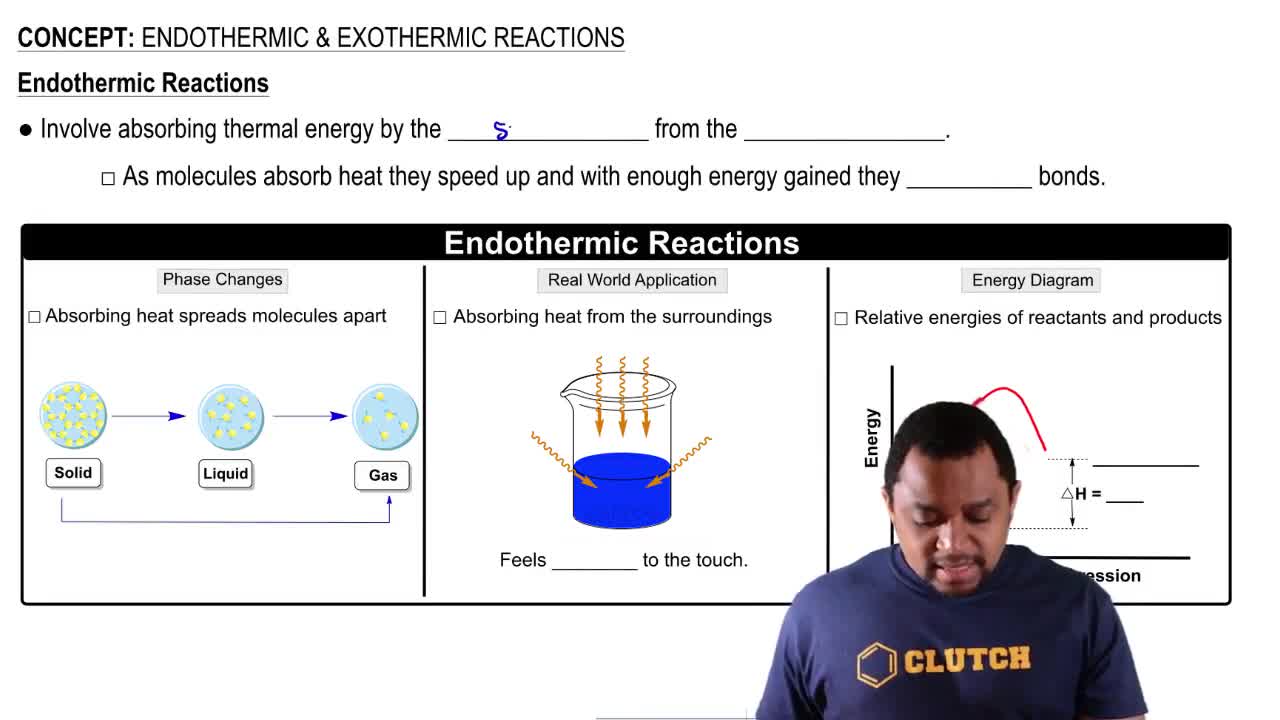At 650 K, the reaction MgCO3(s) ⇌ MgO(s) + CO2(g) has Kp = 0.026. A 10.0-L container at 650 K has 1.0 g of MgO(s) and CO2 at P = 0.0260 atm. The container is then compressed to a volume of 0.100 L. Find the mass of MgCO3 that is formed.
Ch.15 - Chemical Equilibrium
Chapter 15, Problem 80
Consider the endothermic reaction: C2H4(g) + I2(g) ⇌ C2H4I2(g) If you were trying to maximize the amount of C2H4I2 produced, which tactic might you try? Assume that the reaction mixture reaches equilibrium. a. decreasing the reaction volume b. removing I2 from the reaction mixture c. raising the reaction temperature d. adding C2H4 to the reaction mixture
 Verified step by step guidance
Verified step by step guidance1
Identify the nature of the reaction: The given reaction is endothermic, which means it absorbs heat. According to Le Chatelier's Principle, increasing the temperature will favor the endothermic reaction, shifting the equilibrium towards the products.
Analyze the effect of changing reaction volume: Decreasing the volume of a gaseous system increases the pressure, affecting the side of the reaction with more moles of gas. In this case, both sides of the equilibrium have the same number of moles of gas (1 mole of C2H4 and 1 mole of I2 on the reactant side, and 1 mole of C2H4I2 on the product side), so changing the volume would not significantly shift the equilibrium.
Consider the effect of removing a reactant: Removing I2 from the reaction mixture would shift the equilibrium to the left, according to Le Chatelier's Principle, as the system tries to counteract the change by producing more I2. This would decrease the amount of C2H4I2 produced.
Evaluate the impact of adding a reactant: Adding more C2H4 would increase the concentration of one of the reactants, shifting the equilibrium towards the right to produce more C2H4I2, according to Le Chatelier's Principle.
Choose the best tactic: Based on the analysis, the most effective tactic to maximize the amount of C2H4I2 produced would be to raise the reaction temperature, as this would favor the formation of the product in an endothermic reaction.

Verified Solution
Video duration:
2mWas this helpful?
Key Concepts
Here are the essential concepts you must grasp in order to answer the question correctly.
Le Chatelier's Principle
Le Chatelier's Principle states that if a dynamic equilibrium is disturbed by changing the conditions, the position of equilibrium shifts to counteract the change. This principle helps predict how a system at equilibrium will respond to changes in concentration, temperature, or pressure, allowing us to determine the best tactics to maximize product formation.
Recommended video:
Guided course

Le Chatelier's Principle
Endothermic Reactions
An endothermic reaction is one that absorbs heat from its surroundings. In the context of the given reaction, increasing the temperature will favor the formation of products, as the system will shift to absorb the added heat, thus promoting the production of C2H4I2.
Recommended video:
Guided course

Endothermic & Exothermic Reactions
Equilibrium Constant (K)
The equilibrium constant (K) quantifies the ratio of the concentrations of products to reactants at equilibrium for a given reaction at a specific temperature. Changes in concentration or temperature can affect the value of K, guiding decisions on how to manipulate the reaction conditions to favor product formation.
Recommended video:
Guided course

Equilibrium Constant K
Related Practice
Textbook Question
2253
views
Open Question
A system at equilibrium contains I2(g) at a pressure of 0.21 atm and I(g) at a pressure of 0.23 atm. The system is then compressed to half its volume. Find the pressure of each gas when the system returns to equilibrium.
Textbook Question
Consider the exothermic reaction: C2H4(g) + Cl2(g) ⇌ C2H4Cl2(g) If you were trying to maximize the amount of C2H4Cl2 produced, which tactic might you try? Assume that the reaction mixture reaches equilibrium. a. increasing the reaction volume b. removing C2H4Cl2 from the reaction mixture as it forms c. lowering the reaction temperature d. adding Cl2
2119
views
Textbook Question
Consider the reaction: H2(g) + I2(g) ⇌ 2 HI(g) A reaction mixture at equilibrium at 175 K contains PH2 = 0.958 atm, PI2 = 0.877 atm, and PHI = 0.020 atm. A second reaction mixture, also at 175 K, contains PH2 = PI2 = 0.621 atm and PHI = 0.101 atm. Is the second reaction at equilibrium? If not, what will be the partial pressure of HI when the reaction reaches equilibrium at 175 K?
2876
views
Open Question
Is the question asking for something specific about the reaction: 2 H2S(g) + SO2(g) ⇌ 3 S(s) + 2 H2O(g)?
Open Question
Is Ammonia synthesized according to the reaction N2(g) + 3H2(g) ⇌ 2NH3(g) with Kp = 5.3 * 10^-5 at 725K?
